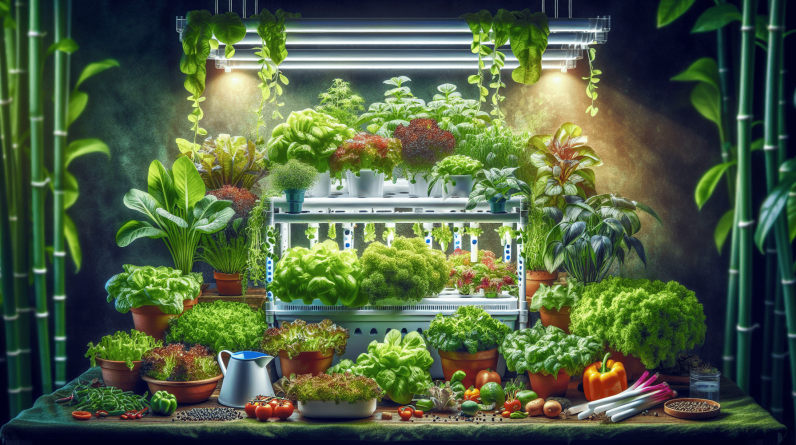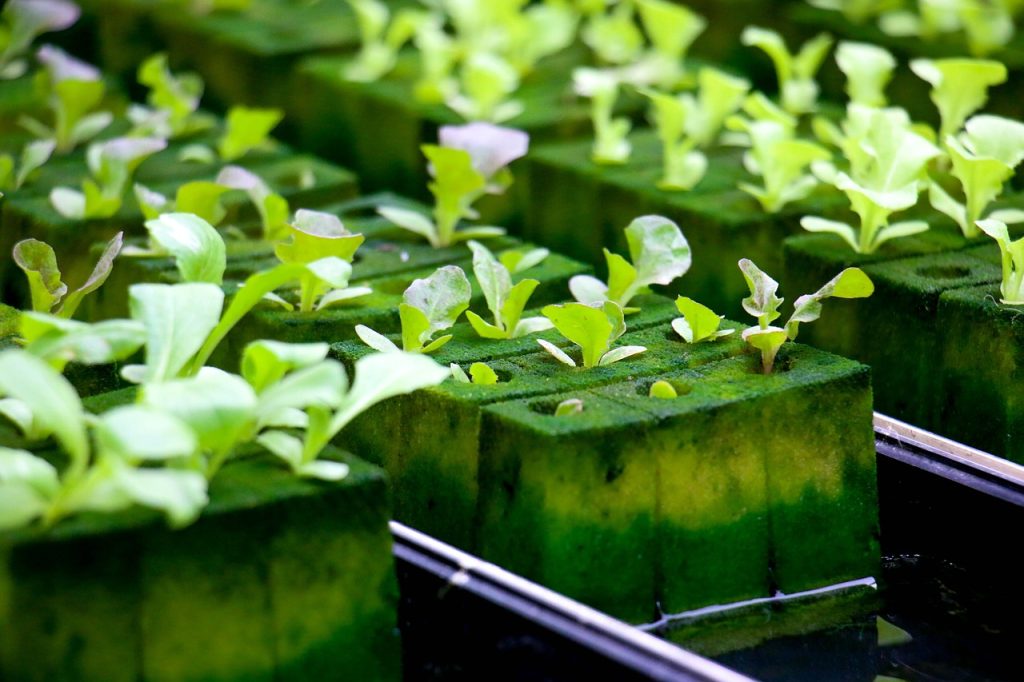
Are you interested in gardening but limited by space or soil quality? Have you considered trying out a hydroponic garden at home? This innovative growing method offers a wealth of benefits and can be surprisingly easy to set up. In this article, we will guide you through the process of creating your own hydroponic garden, from selecting the right system to maintaining your plants. Let’s get started!

Understanding Hydroponic Gardening
Hydroponic gardening is a method of growing plants without soil. Instead, plants are grown in a nutrient-rich solution that provides all the necessary minerals and vitamins directly to the roots. This method allows plants to grow faster and produce higher yields compared to traditional soil gardening. By eliminating the need for soil, hydroponic gardening conserves water and reduces the risk of soil-borne diseases.
Benefits of Hydroponic Gardening
One of the key advantages of hydroponic gardening is its water efficiency. hydroponic systems use up to 90% less water than traditional soil gardening methods, making them an environmentally friendly choice. Additionally, hydroponic gardens can be set up indoors, allowing for year-round cultivation regardless of external weather conditions. This enables you to grow fresh produce even in the middle of winter.
Selecting the Right Hydroponic System for Your Home
There are several types of hydroponic systems available, each with its own set of advantages and requirements. The most common systems include Deep Water Culture (DWC), Nutrient Film Technique (NFT), and Ebb and Flow systems. When choosing a system for your home, consider factors such as space limitations, budget, and the types of plants you want to grow.
Deep Water Culture (DWC) System
The DWC system is one of the simplest and most popular hydroponic systems for beginners. Plants are suspended in a nutrient solution with their roots directly submerged in water. An air pump is used to oxygenate the water and prevent root rot. DWC systems are easy to set up and maintain, making them a great choice for first-time hydroponic gardeners.
Nutrient Film Technique (NFT) System
In an NFT system, plants are grown in channels or tubes where a thin film of nutrient solution continuously flows over the roots. This provides a constant supply of nutrients while also allowing the roots access to oxygen. NFT systems are space-efficient and ideal for growing leafy greens and herbs.
Ebb and Flow System
The Ebb and Flow system, also known as the Flood and Drain system, involves flooding the plant roots with a nutrient solution at regular intervals. The solution is then drained back into a reservoir, allowing the roots to access oxygen. This system is versatile and can accommodate a wide range of plants, from lettuce to tomatoes.
Setting Up Your Hydroponic Garden
Now that you have selected the right hydroponic system for your home, it’s time to set up your garden. Here is a step-by-step guide to help you get started:
-
Assemble Your Equipment: Gather all the necessary components for your chosen hydroponic system, including a reservoir, grow tray, water pump, air pump, growing medium, and nutrients.
-
Set Up the Reservoir: Place the reservoir in a convenient location near a power source. Fill the reservoir with water and add the appropriate amount of nutrient solution according to the manufacturer’s instructions.
-
Install the Water Pump: Connect the water pump to the reservoir and position it in a way that allows it to circulate the water effectively through the system.
-
Position the Grow Tray: Place the grow tray above the reservoir, ensuring that it is stable and level. Fill the tray with your chosen growing medium, such as perlite or clay pebbles.
-
Plant Your Seeds or Seedlings: Carefully plant your seeds or seedlings in the growing medium, making sure that they have enough space to grow and thrive.
-
Set Up the Lighting: If you are growing plants indoors, you will need to provide artificial lighting. LED grow lights are a popular choice for hydroponic gardens, as they are energy-efficient and produce the necessary wavelengths for plant growth.
-
Monitor Your Plants: Regularly check the pH and nutrient levels in your hydroponic system to ensure that your plants are receiving the right amount of nutrients. Adjust the levels as needed to promote healthy growth.

Maintaining Your Hydroponic Garden
Just like traditional gardening, hydroponic gardens require regular maintenance to ensure optimal plant growth and yield. Here are some essential maintenance tips to keep your hydroponic garden thriving:
Monitoring pH Levels
The pH level of the nutrient solution plays a crucial role in plant growth. Most plants prefer a slightly acidic pH of around 5.5 to 6.5. Use a pH meter to test the pH levels regularly and adjust them using pH up or down solutions if necessary.
Checking Nutrient Levels
Plants in a hydroponic system rely entirely on the nutrient solution for their growth. It is essential to monitor the nutrient levels regularly and replenish them as needed. Follow the manufacturer’s instructions for mixing and adding nutrients to ensure that your plants receive the right balance of minerals.
Cleaning and Sterilizing
To prevent the growth of algae and harmful bacteria, it is important to clean and sterilize your hydroponic system regularly. Empty the reservoir, clean the grow tray, and disinfect the entire system with a mild bleach solution. This helps maintain a healthy growing environment for your plants.
Pruning and Harvesting
Regularly prune your plants to remove dead or diseased leaves and promote new growth. Harvest your crops as they mature to encourage continuous production and prevent overcrowding in the grow tray. Be sure to use sharp, sterile tools to avoid damaging the plants.
Troubleshooting Common Issues
Even with proper care and maintenance, hydroponic gardens may encounter occasional problems. Here are some common issues and solutions to help you troubleshoot your hydroponic system:
Nutrient Deficiencies
If your plants exhibit signs of yellowing leaves or stunted growth, they may be experiencing a nutrient deficiency. Check the pH and nutrient levels of the solution and adjust them accordingly. Consider supplementing with specific nutrients to address deficiencies.
Root Rot
Root rot is a common issue in hydroponic systems caused by overwatering or poor oxygenation. To prevent root rot, ensure that your plants’ roots have access to oxygen and avoid overwatering. Trim any damaged roots and treat the system with a hydrogen peroxide solution to disinfect the roots.
Algae Growth
Algae growth in a hydroponic system can block the flow of water and nutrients to your plants. To combat algae, cover the grow tray to block out light, reduce the temperature of the nutrient solution, and maintain proper water circulation. Regular cleaning and sterilization also help prevent algae growth.
Pests and Diseases
While hydroponic systems are less prone to soil-borne pests and diseases, they can still be affected by airborne pests or fungal infections. Inspect your plants regularly for signs of pests or diseases, such as yellowing leaves or unusual spots. Treat affected plants with organic pest control solutions or fungicides to prevent the spread of pests and diseases.

Conclusion
By now, you should have a good understanding of how to set up and maintain a hydroponic garden at home. Whether you are a novice gardener looking to experiment with a new growing method or a seasoned green thumb seeking to expand your gardening skills, hydroponics offers a sustainable and efficient way to grow fresh produce year-round. With the right knowledge and dedication, you can enjoy a flourishing hydroponic garden right in your own home. Happy gardening!
Related Content
- 20 Effective Hydroponic Garden Systems (2025 Guide to Grow Big)
- The Ultimate 2025 Guide to Hydroponic Growing Towers: 10 Effective Strategies to Boost Your Harvest
- Achieving Optimal Temperature and Humidity Levels in Your Hydroponic Growing System
- Is Hydroponic Gardening Truly Better Than Soil?
- Water Conservation in Hydroponic Systems










